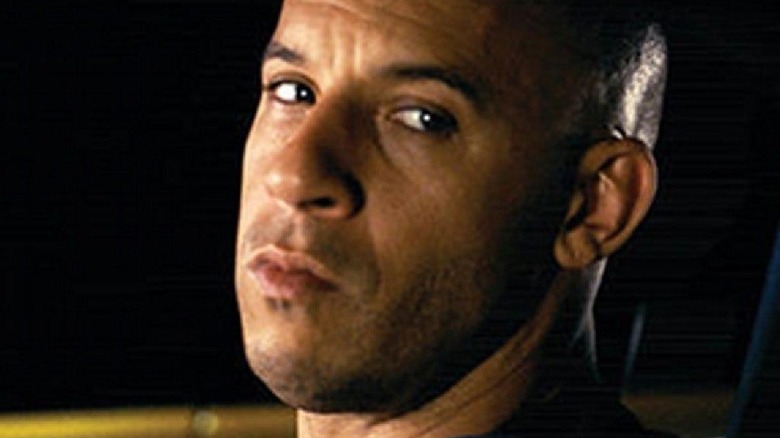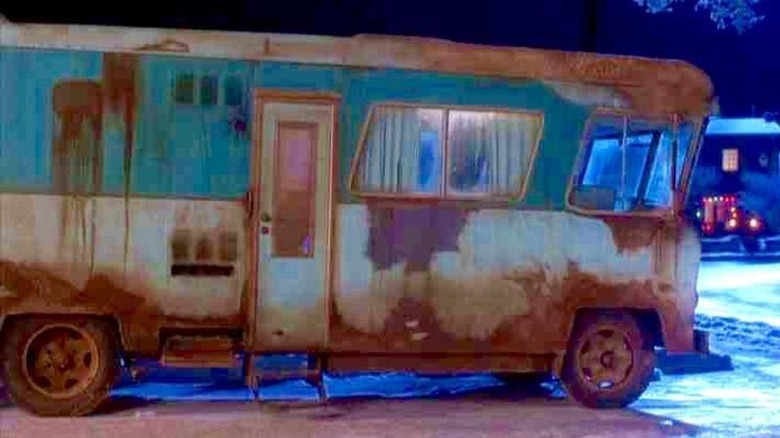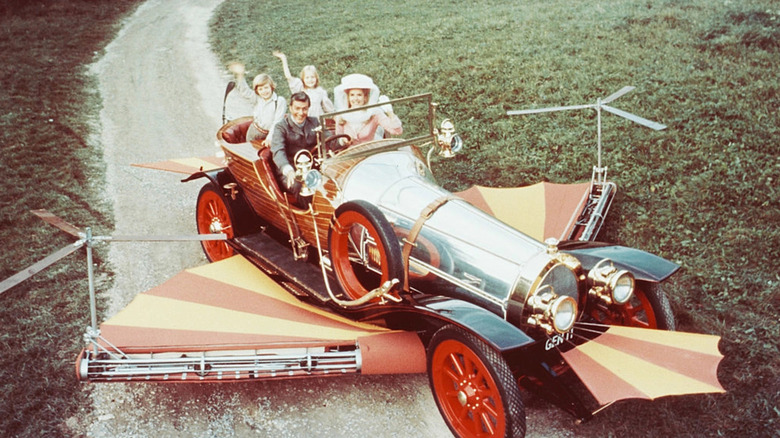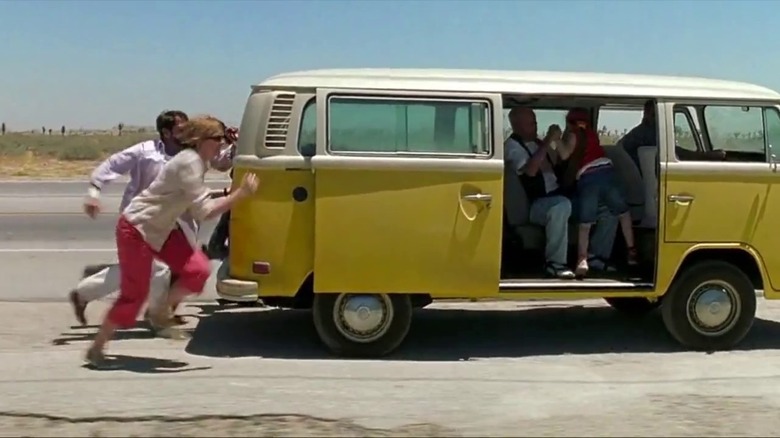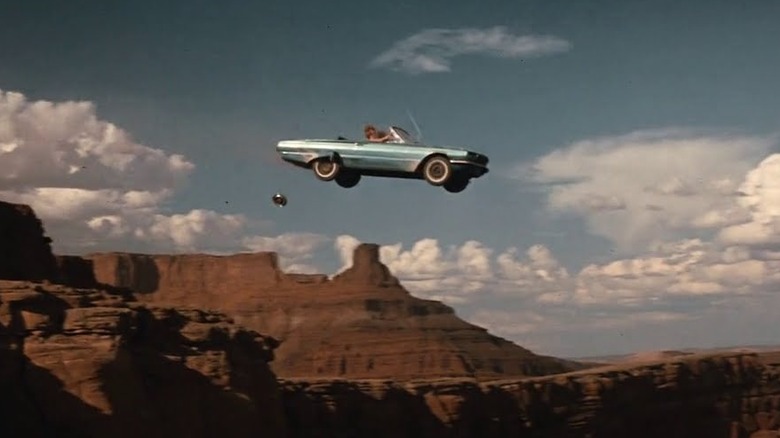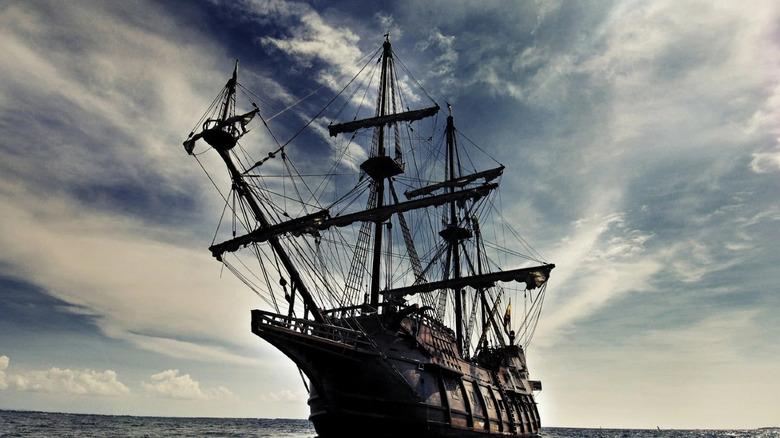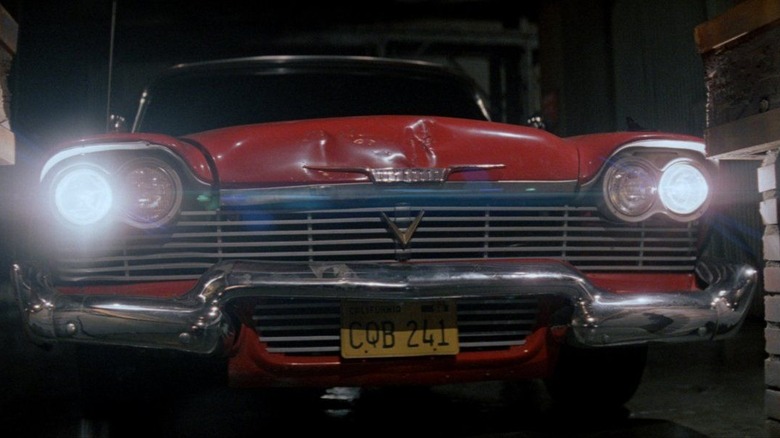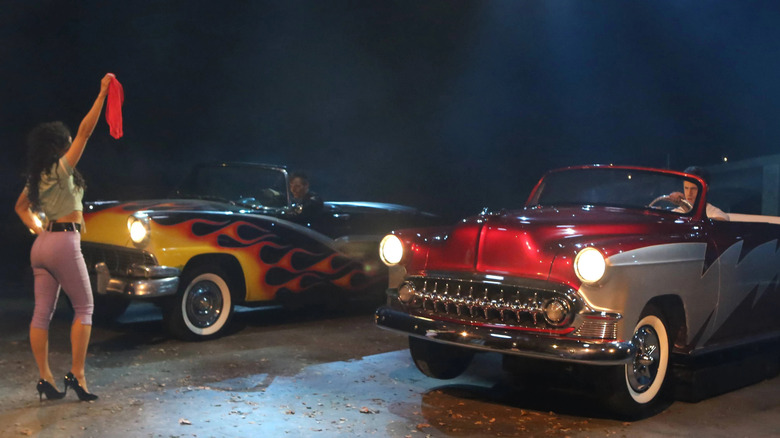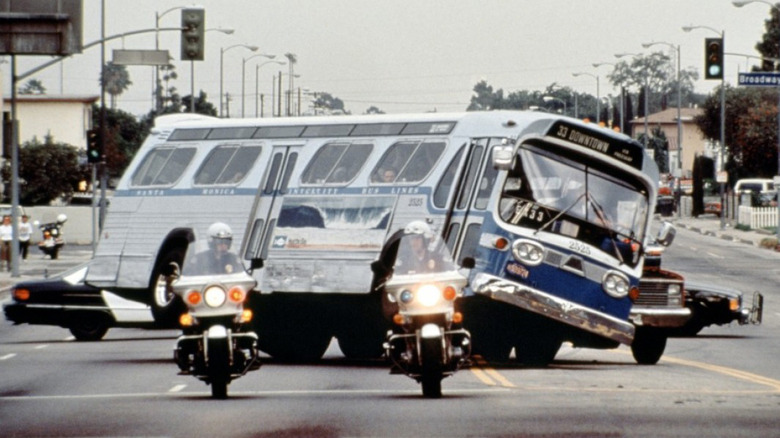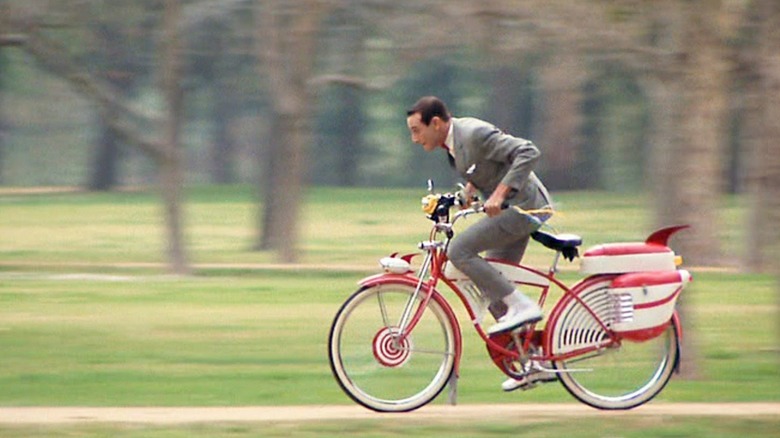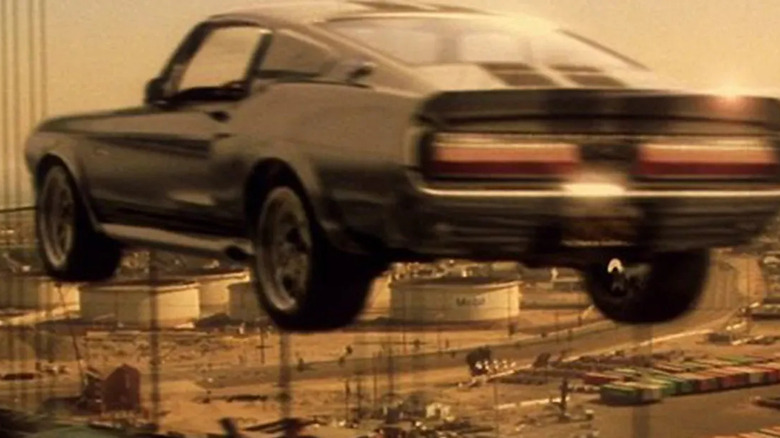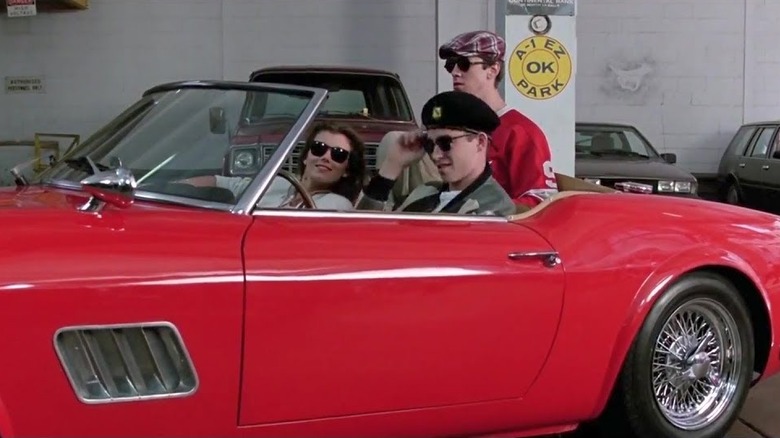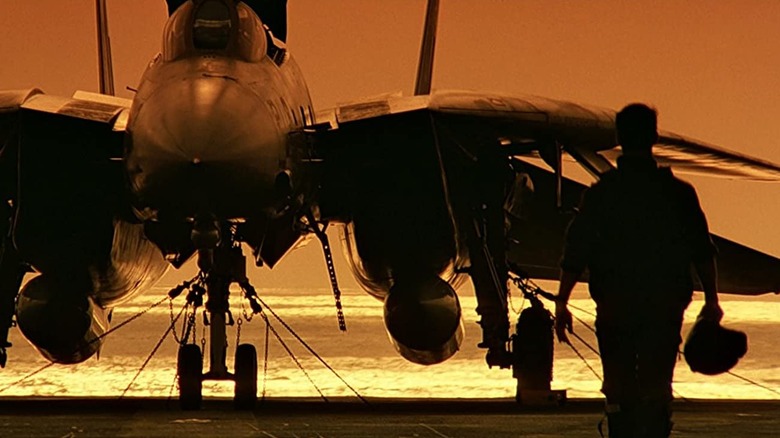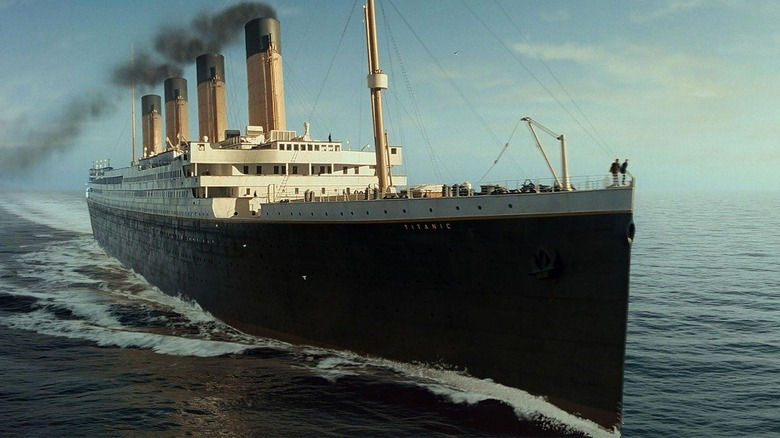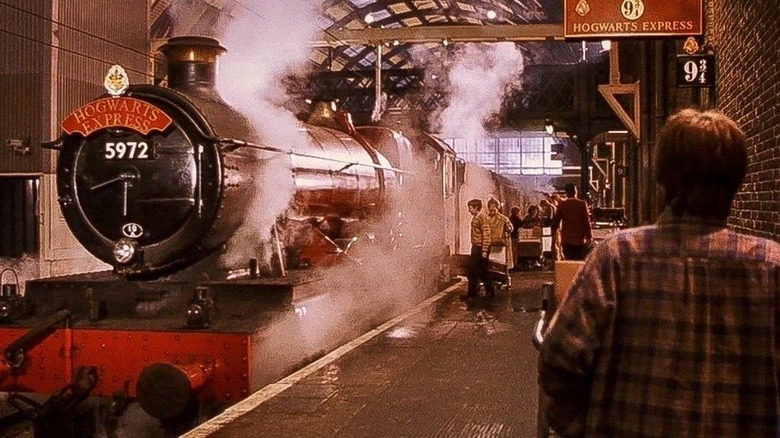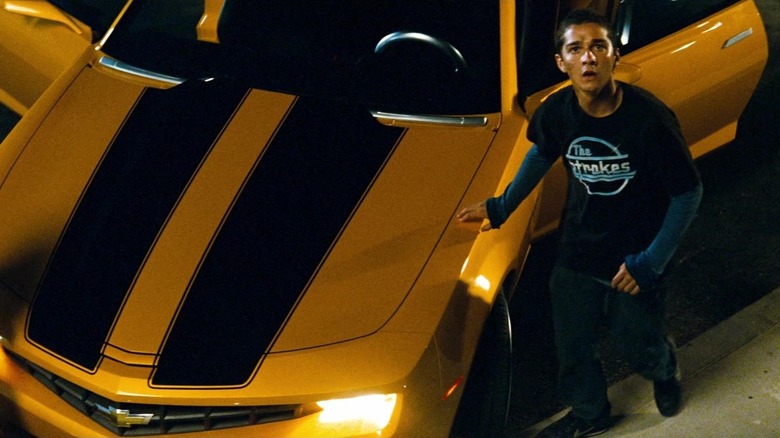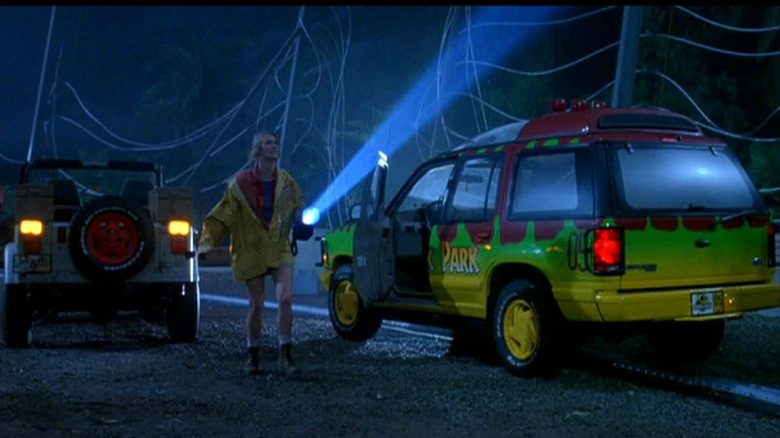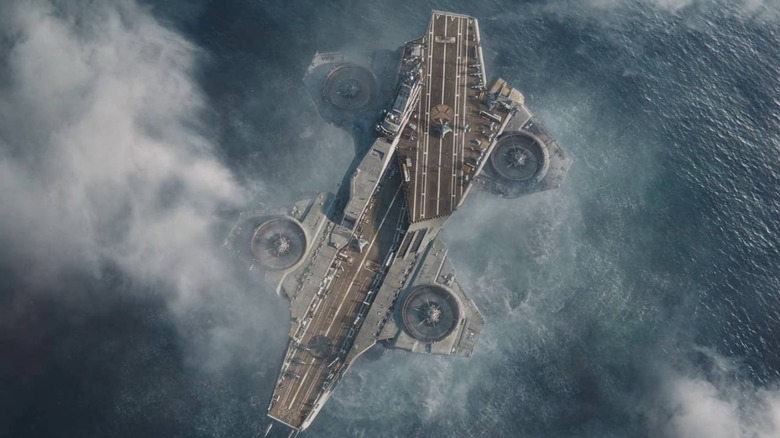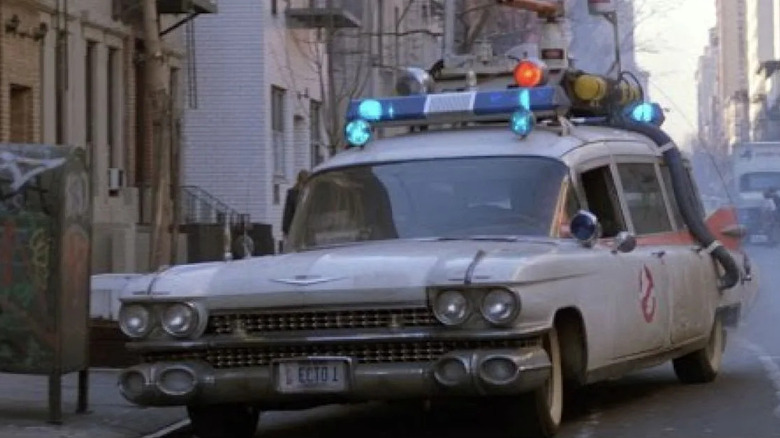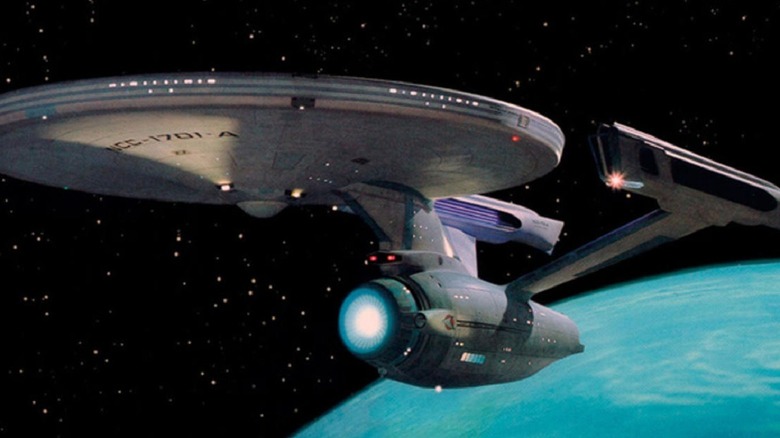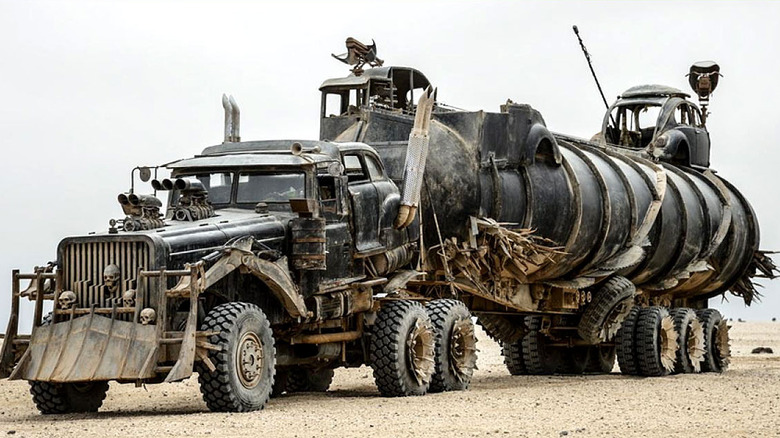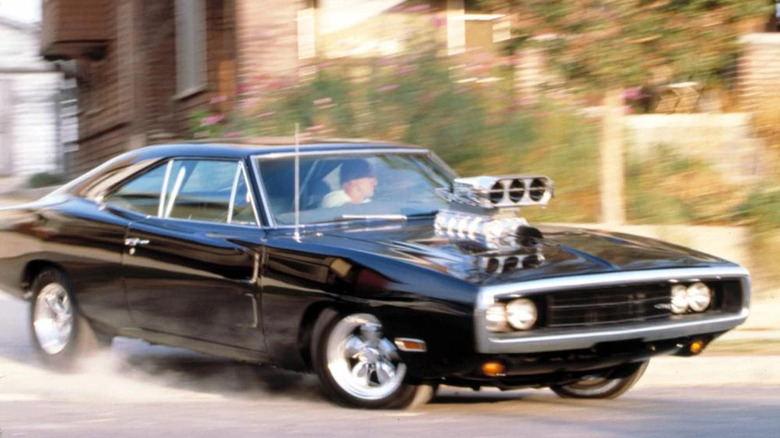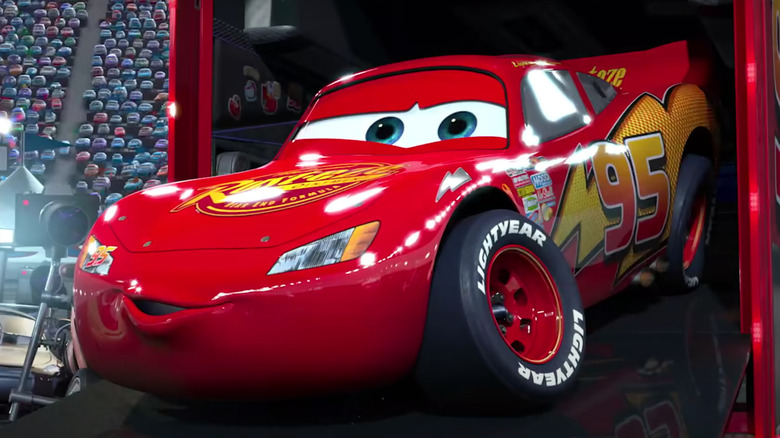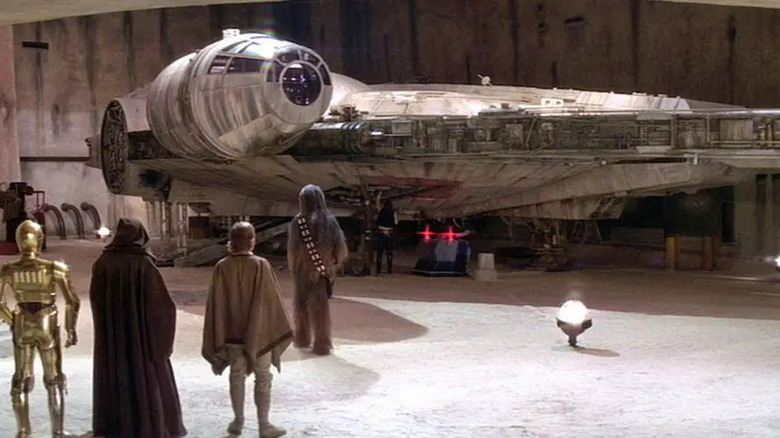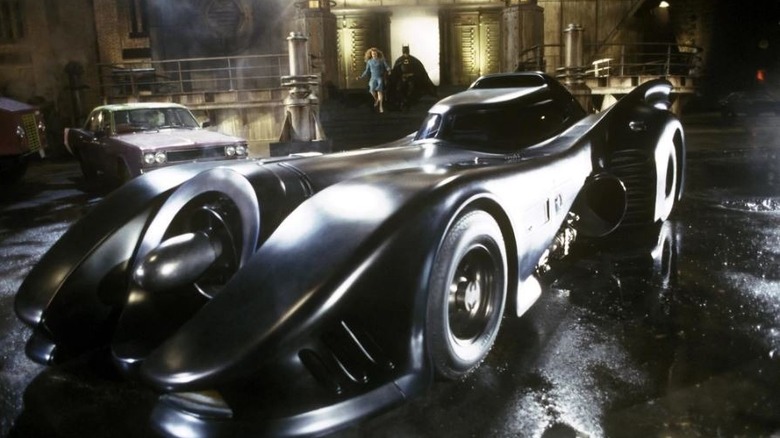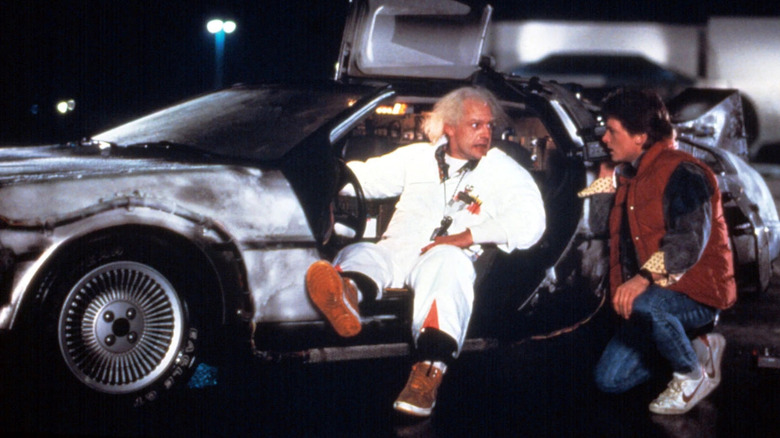The Most Memorable Movie Vehicles Of All Time
Movies get acclaim and awards for their original storylines, their relatable characters, their fantastical settings, their quotable dialogue, and their stunning visual effects. But there's something else that's been making movies extra cool since at least as far back as 1903's "The Great Train Robbery." Some of the most thrilling, most hilarious, and most significant movie moments happen in or around vehicles.
As the years have passed and technology has changed, so too have the types of vehicles that show up in movies, as well as the way in which they're fully realized on screen. Everything from vintage roadsters to historical sea vessels to futuristic spacecraft and even sentient cars can be rendered with models, replicas, or computer-generated images. Just as people love their cars in the real world, the characters in some of the cinema's most beloved films — and especially in big-budget franchises — get really attached to their rides. So do the fandoms that follow them. These are the big screen's most memorable vehicles.
25. Cousin Eddie's RV -- National Lampoon's Christmas Vacation
This 1989 Christmas season staple is, like most of the "National Lampoon" movies, a series of pretty funny gags and skits held together by a fairly thin plot. In "National Lampoon's Christmas Vacation," Clark Griswold intends to surprise his immediate family with a swimming pool he plans to purchase — with the large bonus check he's expecting to arrive in the mail — all while he and his wife host their extended families. "Christmas Vacation" is full of memorable moments, such as Clark's overly-ambitious light display, the overcooked turkey, and the tree going up in flames. But the holiday classic is best remembered for Cousin Eddie and his RV.
Eddie and his brood surprise the Griswolds by pulling their rusted-out motorhome into the driveway. Clark soon learns that his brother-in-law has lost the family home. They're living out of the hunk of junk and they can't afford presents for their children. What could have easily been a depressing or offensive subplot is instead played for laughs about family members who don't understand boundaries. The infamous scene involving Eddie's backed-up sewage tank is just one example. The RV scenes are so burned into fans' memories, Cousin Eddie costumes have become popular come Halloween (especially at the campground). You can see the real RV at Castle Noel, a museum dedicated to Christmas movie memorabilia in Medina, Ohio.
24. Chitty Chitty Bang Bang -- Chitty Chitty Bang Bang
"Chitty Chitty Bang Bang" is — like the vehicle for which it's named — a strange but delightful hodgepodge of a movie. It began life as a 1964 Ian Fleming novel and was also adapted into a stage play, but the 1968 film (co-written by Roald Dahl) is most familiar to the public.
In this children's musical fantasy film, two kids, their widowed inventor dad (Dick Van Dyke), and his socialite sort-of girlfriend Truly Scrumptious (Sally Ann Howes) attempt to salvage an old racecar with a noisy engine. "Chitty Chitty Bang Bang" then morphs into a much more heightened story within a story. Our four main characters and their kindergartener's drawing-slash-Swiss-army-knife of a vehicle must flee the ridiculously tyrannical but immature Baron Bomburst (Gert Frobe). The Baron has outlawed children so that he may enjoy things like toys, games, and the magical Chitty Chitty Bang Bang for himself. Any kids his Child Catcher comes across are imprisoned under his castle. The car is both the object of the Baron's desire and the kids' best hope for rescue.
"Chitty Chitty Bang Bang" makes a cameo in Kenneth Branagh's semi-autobiographical 2021 film "Belfast," where young Buddy's family is impressed by its visuals. Six versions of the car were created for production.
23. The VW minibus -- Little Miss Sunshine
2006's "Little Miss Sunshine" made the journey from Sundance Film Festival darling to box office smash and multiple Academy Award nominee effortlessly. The same cannot be said about the Hoover family's journey from Albuquerque, New Mexico to Redondo Beach, California in their vintage yellow and white Volkswagen van. Their daughter, Olive (Abigail Breslin), desperately wants to compete in a pageant there. She's been practicing her dance routine with her acerbic, drug-addicted, but doting grandpa (Alan Arkin). Meanwhile, her father's waiting to hear if he's landed a book deal, her brother has decided to become a nihilist, and her uncle has attempted to take his own life. Those are just the setbacks that happen before the Hoovers hit the road.
Their lemon of a ride is another constant obstacle, and it's as much a part of the movie as Greg Kinnear, Toni Collette, Steve Carrell, or Paul Dano. The VW bus is also a clever metaphor for the film's central theme. The more that goes wrong — and "Little Miss Sunshine" is almost entirely about things going wrong — the more supportive the members of the family become of each other. Their minibus might be breaking down and falling apart, but with a push now and then, it gets them where they need to go in the end.
22. The 1966 Ford Thunderbird convertible -- Thelma and Louise
Ridley Scott's 1991 buddy-road-dramedy takes some seriously unexpected turns. Starring Geena Davis and Susan Sarandon in the title roles, "Thelma and Louise" starts up like a lighthearted chick flick about two best friends from Arkansas going on vacation, but it quickly shifts gears to explore weighty topics such as spousal abuse, assault, and whether women can really trust the system. "Thelma and Louise" is unsettling and occasionally violent, but it somehow retains its free spirit and comedic bent throughout. This is particularly true of its final scene, which is one of the most famous — and has become one of the most referenced and parodied — in cinema history.
The 1966 Ford Thunderbird convertible plays a considerable role, not just in that shocking ending, but throughout what critic Kenneth Turan calls Thelma and Louise's neo-feminist road trip. What begins for the women as one kind of escape becomes another as the car comes to symbolize their autonomy and freedom. It's notable that, though the audience knows Thelma and Louise will die, the last shot is of the Thunderbird hovering in mid-air against a white background, meaning their choice as opposed to their death is what's important.
21. The Black Pearl -- Pirates of the Caribbean
2003's "Pirates of the Caribbean: The Curse of the Black Pearl" was a far better movie than anyone expected from a film based on a mid-tier amusement park ride. The Black Pearl from the film's subtitle has gone on to appear in all five films as well as several video games, but it's the original in which the ship matters most to the story. When the Black Pearl and its marauding undead pirates swarm Port Royal and abduct Elizabeth Swan, the Governor's daughter, her unlikely love interest, Will Turner, and the notorious but captured pirate, Jack Sparrow, team up to get the girl and the ship back. Sparrow is the Pearl's rightful captain, but its current commander, Barbossa, staged a mutiny.
Making the Black Pearl (as well as the other two ships that feature prominently in the film) seem properly realistic presented an enormous challenge for the production design team. In the first installment, the Pearl is mostly a set built atop a barge. However, after its massive success, the sequels went bigger and made the Pearl seaworthy. Jack's beloved vessel goes through many changes as the franchise progresses, so as well-known as it is to fans and parkgoers, there isn't one definitive Black Pearl.
20. Christine -- Christine
"Christine" was a 1983 novel by Stephen King which was adapted into a film that very same year by John Carpenter. Both men are considered masters of the horror genre now, but "Christine" came early in their careers, and the movie performed moderately well at best with critics and audiences. It has, however, become something of a cult favorite in the years since.
In this bizarre supernatural thriller, a nerdy teenager named Arnie buys a beater car — a red and white 1958 Plymouth Fury named Christine — from its deceased previous owner's family and begins to restore her. He learns that a string of deaths have been attributed to the vehicle, and as he spends time with her at the garage, his personality begins to change. It turns out that Christine isn't just sentient, she's controlling and bloodthirsty. The classic car antagonizes anyone who gets in Arnie's way, then anyone who gets in the way of her relationship with her new owner.
Though she's definitely more machine than woman, Christine is almost treated like a human body often is in a horror film, subjected to extreme violence only to emerge to alternately inflict or endure more pain. In his largely positive review, Roger Ebert said of the titular Plymouth, "By the end of the movie, Christine has developed such a formidable personality that we are actually taking sides during its duel with a bulldozer."
19. Greased Lightning -- Grease
This 1978 movie about the 1950s is a sleepover mainstay whose songs remain popular to this day. Starring John Travolta and Olivia Newton John, "Grease" tells the age-old story of opposites attracting. After a beachy summer fling, Danny and Sandy discover they now go to the same high school. The problem is, Sandy's a good girl, Danny's a bad boy, and they both need to maintain their reputations. Danny's devil-may-care attitude is represented by his slicked back hair, his leather jacket, and his interest in endeavors such as illegal street racing over wholesome activities like track and field.
Danny, his right hand man Kenickie, and the rest of the Greasers are customizing a car, dubbed Greased Lightning, with stolen parts. In both the movie and the play that preceded it, the song about that car is one of the standout numbers. The car only reappears in the musical so that Danny and Sandy can go on a date, but in the film version, Greased Lightning gets more to do. When Kenickie hits his head and can't drag race against the rival T-Bird gang, Danny gets behind the wheel. Seeing her old beau in danger, and then seeing him victorious, convinces a still goodie-two-shoes Sandy that she does love Danny. She changes her attitude and look — ditching her modest dress for a tight black ensemble — and rides a flying Greased Lightning with Danny into the film's end credits.
18. The bus -- Speed
Today, Keanu Reeves and Sandra Bullock are Hollywood heavyweights who studios can depend upon to sell an action movie, but back in 1994 when "Speed" debuted in theaters, their star power was largely untested, and filmmakers weren't sure that audiences would buy into the movie's simple (but kind of silly) premise. A terrorist has placed a bomb underneath a Santa Monica public bus. Once that bus accelerates above 50 miles per hour, the explosive will activate. If the bus decelerates below 50 mph, it'll detonate, killing everyone aboard. Enter SWAT team officer Jack (Reeves) and leadfooted passenger Annie (Bullock) to save they day.
The villain's plans and motives aren't the most sensible, and the physics aren't particularly plausible, but they do make for what's essentially one big, unforgettable, and enjoyable action sequence. Critics and crowds were all too happy to embark on this death-defying trip through L.A. traffic in a vintage blue and white General Motors bus. So much of "Speed" takes place in and around that bus that viewers were intimately familiar with it by the time the film comes to its fiery conclusion. "The Making of Speed" documentary explains how digital effects allowed for that impossible jump over an unfinished stretch of highway, but about a dozen real buses were used for most scenes. Many had to be blown up or crashed, but one listed in good condition sold at auction for $102,000 in 2018.
17. Pee Wee Herman's bike -- Pee Wee's Big Adventure
1985's "Pee Wee's Big Adventure" was the first film featuring Paul Reuben's bizarre and hilarious alter ego as well as the directorial debut of Tim Burton. Reuben began playing Pee Wee Herman in stage shows about five years earlier, but this cult classic comedy, loosely based (via The Ringer) on the 1948 Italian drama "Bicycle Thieves," spawned two more Pee Wee movies and a television series while launching Burton's career.
Pee Wee Herman really loves his tricked-out red and white bicycle, so much so that he won't even sell it for "a hundred million, trillion, billion dollars." He goes absurdly overboard when chaining it to bike racks because he fears that his nemesis, Francis, is going to steal it someday. When the bike is stolen and the police offer little help, Pee Wee advertises a $10,000 reward for its return. Getting the bike back is the impetus for Pee Wee's big adventure. He hitchhikes to Texas, meets some colorful characters along the way, and becomes the star of his own movie within a movie. Fans can see the real thing at the Bicycle Museum of America in New Bremen, Ohio. Prior to being put on display in the museum, it sold for $36,000 on eBay.
16. Eleanor the Shelby Mustang -- Gone in 60 Seconds
It's always a strong sign that a car is going to be an important part of a movie when it has a first name. Eleanor is a 1967 Ford Shelby Mustang GT500 and the object of Randall "Memphis" Raines' (Nicolas Cage) affections. She's also one of 50 MacGuffins in this fast-paced automobile-themed heist movie which also stars Angelina Jolie, Robert Duvall, and Delroy Lindo. In "Gone in 60 Seconds," retired car thief Memphis has three days to steal the aforementioned 50 high-priced and rare vehicles for a crime lord, or else that crime lord will crush his brother in a compactor. Eleanor is the white whale that eluded Memphis back in his lawbreaking days and the one that will be hardest for Memphis and his assembled crew to bring in unscathed.
Some 12 Eleanors (five of which survived production) were created for the movie, which uses mostly practical effects. Only three of them were fully operational and were actually driven by the film's stars. Unfortunately for "Gone in 60 Seconds," neither critics nor audiences loved the movie as much as "The Fast and the Furious," which premiered the following year in 2001 and became a franchise with an enormous global following. But at least Memphis and Eleanor got their happy ending.
15. 1961 Ferrari 250 GT California Spyder -- Ferris Bueller's Day Off
John Hughes' seminal 1985 high school comedy "Ferris Bueller's Day Off" feels so authentic because, at least in its first half, it's basically a series of vignettes that amount to exact how a trio of teens playing hooky would imagine spending their time. Rather than just linger in bed, as Cameron wants to do, Ferris, his girlfriend and Cameron take a treat-yourself-style tour of Chicago in Cameron's dad's 1961 Ferrari 250 GT California Spyder. Cameron, who majorly stresses about obeying his exacting father, fears he'll notice the difference in the odometer reading. But Ferris, whose entire personal philosophy is that everyone should relax and live a little, promises it'll all be okay.
Of course, it isn't, and when they surrender the keys to the attendants at a downtown parking garage, the employees take the Ferrari for a 175-mile spin of their own. Ferris and Cameron only realize something is amiss once they return from their day out and try to reset the mileage. They attempt to rewind the meter, but during an emotional scene in which Cameron decides to stand up to his dad about the fact that he loves his car more than his son, he takes his anger out on the Ferrari and accidentally sends it flying backwards into a wooded ravine below. In the DVD commentary, Hughes explains that the close-ups are of an authentic Spyder, of which only about 100 remain, while the wide shots capture a "pretty good replica."
14. The Grumman F-14 Tomcat -- Top Gun
1986's "Top Gun" opens with an extended action scene in which Maverick (Tom Cruise) and Goose (Anthony Edwards) fend off two hostile MiG-28s with their F-14 Tomcat fighter jet before being invited to an elite Naval flight school in California. Though there's plenty of time for romance and rivalry on the ground, a respectable portion of "Top Gun" takes place in the air, where we get to see everything the F-14 can do from inside and outside the cockpit.
Navy pilot turned NASA astronaut Scott Altman was one of the pilots who actually flew those Tomcats during the movie's many stunts, including the moment in which Maverick disregards orders and buzzes past the control tower in a reckless flyover. The military worked closely with the producers and director Tony Scott on the film, and the use of real Defense Department equipment didn't come cheap. The rental and fuel for the aircraft ran about $7,600 per hour (in 1980s money), and if things didn't go just right, the film was unusable.
"Top Gun" is remembered, in part, for the friendship between Maverick and Goose, and the latter's tragic demise. Sadly, in a case of life imitating art, pilot Art Scholl died trying to capture the failed flat spin maneuver that kills Goose in the film. Scholl was hired to perform aerial stunts with cameras mounted, but after he crashed in the Pacific Ocean, neither his body nor his plane were ever recovered. "Top Gun" is dedicated to his memory.
13. The RMS Titanic -- Titanic
Relatively few of the entries on this list have their basis in the real world (perhaps that's because we don't pass vehicles as bizarre as Chitty Chitty Bang Bang or the Black Pearl on the street everyday). The RMS Titanic is not only one of the most famous movie vehicles ever, it's one of the most famous vehicles in history. James Cameron's film, "Titanic," smartly superimposes Jack and Rose's love story onto the tale of the doomed ship (everybody already knows how the Titanic's story ends), but the film's record-breaking success was also thanks to the impressive accuracy with which it recreated the unthinkably big ocean liner.
Though "Titanic" starts and ends with a framing device in which Bill Paxton's researcher, Brock Lovett, is looking for that big blue necklace, the vast majority is set aboard the titular ship. Cameron explores the massive top deck to impressive effect. He takes us into the grand dining rooms, the grimy engine rooms, the glamourous first class quarters and the cramped third class cabins. "Titanic" is just as visually impressive when Jack and Rose live it up on the floating city upon the sea as it is when that dream world literally breaks in two and begins to sink into oblivion.
12. Hogwarts Express -- Harry Potter
Disney's Pirates of the Caribbean ride may have inspired a film franchise, but in the case of "Harry Potter," the franchise inspired the ride, which connects the two theme parks of Universal Studios Orlando. The Hogwarts Express allows guests to experience exactly what Harry did in the first book and movie. They can pass through the brick wall at Platform 9 3/4 with their gear in tow, then board the magical red and black train as they enjoy some sweets and John Williams' rapturous score en route to their destination.
One of the most successful parts of the "Harry Potter" films was the extent to which the production design matched the imaginations of already obsessed book readers. The Hogwarts Express is just one example. The enchanted train does its part to create some of Wizarding World's charming, exceedingly British atmosphere, and it's an essential part of the narrative. Some of Harry's most formative moments — from meeting the Weasleys to fighting off dementors — happen on or because of the Hogwarts Express.
Fans who want to own a piece of Potterdom can buy painstakingly detailed train sets of the Hogwarts Express, not to mention a Lego set and countless other paraphernalia bearing its logo.
11. Bumblebee as a Camaro -- Transformers
There are a few franchises on this list in which cars and other vehicles play as integral a role as the characters, but the "Transformers" movies take that concept to another level. The toy-turned-Saturday-morning-cartoon-turned-expensive-sci-fi-action-series did add more human beings than were necessary in previous iterations, such as Shia LaBeouf's Sam Witwicky and Megan Fox's Mikaela Banes. Still, fans go to the movie theater to see the Autobots and Decepticons in all their larger-than-life mechanical glory.
Every kid has their favorite Transformer, but a random sampling would probably favor Bumblebee. Perhaps that's why director Michael Bay chose the recognizable and lovable black and yellow Cybertronian for Sam's first encounter with a Transformer. Sam buys Bumblebee, disguised as a 1976 Chevy Camaro, in part because he thinks a cool car might have the power to impress Mikaela. That it does, but Sam is taken aback when it turns out his new ride also has the power to transform into a huge autonomous robot, then turn back into a later model Chevy. After a quick rescue effort, Bumblebee decides to go incognito as a 2006.
From Optimus Prime to Megatron, audiences got what they wanted out of 2007's first "Transformers" film: impressively big, realistically rendered versions of the plasticky things they played with as children. But only Bumblebee was elevated to true co-star.
10. The Jurassic Park Ford Explorers - Jurassic Park
It's said that Steven Spielberg invented the blockbuster with 1975's "Jaws," but he took universally popular filmmaking to another level with 1993's "Jurassic Park." The story of a planned dinosaur-themed vacation destination gone utterly, disastrously wrong is based on a Michael Crichton book of the same name. It became the highest grossing film ever (it still ranks 9th, adjusted for inflation) and began a franchise that's still going strong, as well as an area of Universal Studios' theme parks where rides and attractions recreate some of the movie's best and scariest moments. Many of those moments occur in the film's custom wrapped Ford Explorers, including one of the most iconic movie moments of all time, the T-rex attack.
In the scene, doctors Grant, Sattler, and Malcolm along with a lawyer and the park owner's two grandchildren are out touring exhibits when the power is cut. This allows the living, breathing, terrifying attractions to escape. The grandkids notice a glass of water vibrating in the cupholder of their remotely driven SUV. Seconds later, the T-rex lunges into view. The scene continues for several incredibly tense minutes, as the alpha dino crushes the Explorer with the kids in it and pushes it to the edge of a cliff. "Jurassic Park" and its breathtaking visuals still hold up better than most new releases, three decades later.
9. The helicarrier -- Avengers: Age of Ultron
A great many vehicles have been invented for the Marvel Cinematic Universe. From small scale rides like Captain America's motorcycle to vessels that can hold a whole population like the Asgardian Statesman, the MCU's nearly infinite number of characters need something to travel through space and some way to get places when on Earth. It's probably fair to say, however, that the characters, their costumes, and weapons are, on the whole, more recognizable than their rides. The Quinjet and the Milano are distinctive enough for consideration, but the Helicarrier is the clear MCU choice for this list.
The hulking Helicarrier only shows up from time to time (not nearly as often as the Avengers themselves do), but it's the star of the show in 2015's "Avengers: Age of Ultron," a film which has become increasingly important as the MCU has transitioned to TV. Ultron plots to destroy the world by levitating a large portion of the country of Sokovia into the air then crashing it back to the surface, creating a cataclysmic event that would cause mass extinction. The Avengers must stop him and evacuate as many of the innocent Sokovians onto the Helicarrier as possible. The Helicarrier gets points for being gigantic and thoughtfully designed. Its Lego form is the most expensive and valuable of all MCU sets.
8. The Ectomobile -- Ghostbusters
1984's "Ghostbusters" is an odd duck of a movie the same way the Ectomobile (or the Ecto-1) is an odd duck of a work vehicle. A supernatural thriller comedy starring "Saturday Night Live" alum that earnestly delved into spiritualism, "Ghostbusters" didn't necessarily have a built-in audience the way some franchise starters do. Nevertheless, it became a sensation that expanded into three more movies and a television series, as well as books, comic books, video games, and lots of related merchandise.
The comically weird-looking car the Ghostbusters drive around and bust ghosts in is a 1959 Cadillac Miller-Meteor Futura Duplex with an ambulance-hearse conversion. In the story, Ray Stantz (Dan Aykroyd) purchases it for $4,800, an amount that was not meant to sound cheap by 1980s standards, since Stantz explains that it needs "suspension work and shocks, brakes, brake pads, lining, steering box, transmission, rear end ... maybe new rings, also mufflers, a little wiring." The Ecto-1 gets a fresh coat of white paint, a logo, a call number, and a few other bells and whistles. It looks better, but still ridiculous, and more or less like Aykroyd had imagined during the process of writing the script (it was supposed to be black with purple lights, according to an early draft in which it was capable of interdimensional travel). But even relegated to the streets of New York City, the Ectomobile is still one of the most memorable cars in cinema history.
7. USS Enterprise (NCC-1701) -- Star Trek
The starship Enterprise is familiar to audiences from its many small screen and big screen appearances. It would certainly rank higher if this list focused on TV instead of movies, because that's where most fans were first introduced to the vessel, and that's where most of its most storied missions have taken place for more than 50 years.
But "Star Trek" is a film franchise, too (though its core audience is a little more mature and less apt to buy toys in mass quantities than that other franchise with the word "star" in the title). The 1995 book "The Art of Star Trek" describes how the starship had to be redesigned for 1979's "Star Trek: The Motion Picture." The added details not only improved production value, but were factored into the events of the film as a necessary retrofit. That process has never really ceased throughout the series' 13-film run.
Though the cast and crew around it might change, the Enterprise — even with its additions and subtractions — is a constant. In the imagined future of "Star Trek," Kirk, Spock, and company are aboard a 947-foot-long, 11-deck elegant behemoth of a ship that can house and transport a crew of 430 at faster-than-light speed. But the Enterprise started out as a four-inch model and exists today entirely as a digital effect.
6. Furiosa's war rig -- Mad Max: Fury Road
It had been 30 years since writer-director George Miller had made a "Mad Max" movie. The post-apocalyptic film series had always been seriously gear-headed, but neither critics nor audiences were prepared for 2015's "Mad Max: Fury Road," which amplified everything about the franchise to astounding effect. The fourth installment ending up winning six Academy Awards (the most by any film that year) for its stunning production design, its editing, its sound and more.
Charlize Theron is Furiosa, a war captain who goes rogue against the vile and dictatorial Immortan Joe. She uses her war rig, which is meant to ferry weapons and fuel to Joe's citadel, as an escape vehicle and armored sanctuary with which to free five of Joe's wives from sexual slavery. 2015's Max (Tom Hardy) is being used as a "blood bag" for injured troops, so he's looking to escape, too. Max attempts to steal the war rig as Furiosa is doing repairs, but the two agree to team up to get the women and each other to safety.
Every vehicle in pursuit of Max and Furiosa is aesthetically fascinating, but it's the war rig they're chasing and which we stay with through the nonstop action. The mega-customized, 78-foot, 18-wheeler was fully functional, as was every other truck and bike in "Mad Max: Fury Road," which was filmed without CGI.
5. The Dodge Charger -- The Fast and the Furious
"The Fast and the Furious" franchise is a multi-billion dollar (and counting) juggernaut in which an awesomely tricked-out new street racer revs onto the screen practically every five minutes. Though the series likes to claim it's about family — in particular, Dominic Toretto's family — the cars are the stars just as much as Vin Diesel, Michelle Rodriguez, and the late Paul Walker. But only one car represents family, fury, speed, and power at the climactic moment of the first film: Dom's dad's 1970 Dodge Charger.
Dom and his father bonded as they worked on the car during his childhood. When his father is killed while stock racing, Dom locks it away in a garage, afraid that if he ever got behind the wheel, the same fate could befall him. Of course, fate conspires to force Dom to drive her again. "The Fast and the Furious" ends as Brian in his Toyota Supra and Dom in his dad's Charger give chase to the men who killed their friend, Jesse, then consent to an impromptu race at a stoplight. The modified Charger with its 900-horsepower engine holds the quarter-mile record, but they both just barely evade a passing train for a tie. However, Dom clips a semi-truck, rolls and crashes. He survives and appears to leave the wrecked Charger on the side of the road, but it returns in "Fast and Furious" and "Fast Five," where it helps break him out of prison.
4. Lightning McQueen -- Cars
Of all the movies on this list, none is so thoroughly about cars as much as 2006's "Cars." The Pixar film features exactly zero human characters; it's the motor vehicles themselves who have taken our place in "Cars," which Pixar fans and the internet have theorized about since the movie debuted. Despite some disturbing possible explanations, the animated movie's most loyal fans skew too young to care about such things. Thematically, "Cars" is about slowing down and taking time to enjoy your life and not putting too much pressure on yourself, which might resonate with parents and grandparents. But from the perspective of a five-year-old, it's about talking, brightly colored cars going fast.
Artists conceived of a plethora of anthropomorphized automobiles for "Cars," including a Porsche, a VW Bus, and a forklift. The farm truck, Mater (voiced by Larry the Cable Guy), became something of a breakout star, but it's Owen Wilson's Lightning McQueen that's graced countless T-shirts and lunchboxes ever since. Fans can visit Radiator Springs in Disney's California Adventure theme park and even take a ride in the famous red race car.
It might seem like the fully animated Lightning McQueen would be easier to produce than a physical Camaro or Mustang, but in reality, it was much more of an undertaking. While other production teams on this list could buy or build models, "Cars" required a team of 800 animators working on 3,000 computers, rendering with software that was as complex as the type that's actually used to design real cars.
3. The Millennium Falcon -- Star Wars
Because "Star Wars" takes place a long time ago in a galaxy far, far away, this film franchise doesn't have to abide by the natural laws that govern our own reality. That means transportation methods in the "Star Wars" universe come in all shapes and sizes. Let's be honest: if this list was about the most memorable vehicles in total, "Star Wars" — from its AT-ATs to X-Wings, most of which were designed by Colin Cantwell — would vault to number one. They're all so iconic that almost every starship in the fleet has been Lego-ified several times over.
But one legendary hunk of junk rises above the rest. According to her pilot, Han Solo, "she may not look like much, but she's got it where it counts." Everyone knows the Millennium Falcon is the ship that made the Kessel Run in less than twelve parsecs. She has a backstory that's more richly detailed than most films' main characters and has only grown over the seven live-action "Star Wars" movies in which she appears. "Solo: A Star Wars Story" even gave her an actual personality in the form of the autonomous intelligence of the droid L3-37. The Millennium Falcon's modified flying saucer profile is immediately recognizable today, but model makers had only weeks to create it and played around with junk and spare parts until the design satisfied George Lucas.
2. The Batmobile -- Batman
In a pop culture era in which superheroes are everywhere and seem to be multiplying, Batman has been one of the most enduring. Seven actors have put their own spin on the Caped Crusader, but there are some constants: He's dark and brooding, without any real superpowers besides his fortune and commitment to crime fighting, and he's got a whole Batcave full of cool gadgets. Other comic book characters might have a signature move or weapon, but Batman's most reliable piece of equipment is undoubtedly the Batmobile.
The myriad films in which the character has appeared means that about a baker's dozen of various Batmobiles and other Bat vehicles have been designed and constructed in the last 30-plus years. "The Dark Knight" trilogy had its armored Tumbler. Zack Snyder's films had the even more souped-up Bat-tank with rotating mounted guns. The muscle car version in "The Batman" is emerging as a new fan favorite, but when most people think of a Batmobile, what comes to mind is the sleek but imposing and extremely comic book-y original from Tim Burton's 1989 film, simply titled "Batman."
Keith Short, who designed that Batmobile, explains in a Warner Bros. Home Video documentary called "Building the Batmobile" that he began with a Chevy Impala chassis, added design elements from Salt Flats racers and Sting Rays, then finished it off with Rolls Royce jet engine components and a British Harrier jet nosepiece. Two were made; one is housed in the Peterson Automotive Museum, the other is part of the private collection of one of the film's producers.
1. The DeLorean -- Back to the Future
Robert Zemeckis's "Back to the Future" is (ironically, considering the title) like a time capsule in film form. It features some of the biggest stars of the day (Michael J. Fox, Christopher Lloyd, and Lea Thompson) wearing some of the most era-specific fashion (puffy vests, light-up shoes, holographic baseball caps), and it experiments with film genres that were popular during the decade (wacky, convoluted sci-fi and borderline indecent teen romantic comedy). But the most indelible thing about this iconic movie is Doc Brown's custom DMC DeLorean, which both gives the film its mode of time travel and perfectly captures its heightened 1980s style.
The DeLorean was chosen because it looked like what people in the 1950s might have considered space-age, with its gull-wing doors and its vaguely UFO-like design details. However, when filmmakers began brainstorming the basic idea of "Back to the Future," they didn't necessarily have a car in mind — just a household appliance of some sort. In an early draft, it was a refrigerator, but Steven Spielberg worried that kids would get stuck in fridges trying to time travel at home. Ford offered the production team $75,000 to use a Mustang instead, but co-writer Bob Gale had strong opinions that Doc Brown wouldn't drive a Mustang. The plutonium-powered DeLorean, retrofitted with Doc's flux capacitor, was the perfect marriage of narrative form, function, and innovation (though it did have an annoying habit of breaking down on set). Put simply, no vehicle is as synonymous with a movie as the DeLorean is with "Back to the Future."
